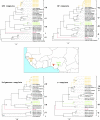New Hosts of The Lassa Virus
- PMID: 27140942
- PMCID: PMC4853722
- DOI: 10.1038/srep25280
New Hosts of The Lassa Virus
Abstract
Lassa virus (LASV) causes a deadly haemorrhagic fever in humans, killing several thousand people in West Africa annually. For 40 years, the Natal multimammate rat, Mastomys natalensis, has been assumed to be the sole host of LASV. We found evidence that LASV is also hosted by other rodent species: the African wood mouse Hylomyscus pamfi in Nigeria, and the Guinea multimammate mouse Mastomys erythroleucus in both Nigeria and Guinea. Virus strains from these animals were isolated in the BSL-4 laboratory and fully sequenced. Phylogenetic analyses of viral genes coding for glycoprotein, nucleoprotein, polymerase and matrix protein show that Lassa strains detected in M. erythroleucus belong to lineages III and IV. The strain from H. pamfi clusters close to lineage I (for S gene) and between II &III (for L gene). Discovery of new rodent hosts has implications for LASV evolution and its spread into new areas within West Africa.
Figures

References
-
- McCormick J. B. & Fisher-Hoch S. P. Lassa fever. Curr. Top. Microbiol. Immunol. 262, 75–109 (2002). - PubMed
-
- Frame J. D., Baldwin J. M. J., Gocke D. J. & Troup J. M. Lassa fever, a new virus disease of man from West Africa. Am. J. Trop. Med. Hyg. 19, 670–676 (1970). - PubMed
-
- Monath T. P., Newhouse V. F., Kemp G. E., Setzer H. W. & Cacciapuoti A. Lassa virus isolation from Mastomys natalensis rodents during an epidemic in Sierra Leone. Science 185, 263–265 (1974). - PubMed
-
- McCormick J. B., Webb P. A., Krebs J. W., Johnson K. M. & Smith E. S. A prospective study of the epidemiology and ecology of Lassa fever. J. Infect. Dis. 155, 437–444 (1987). - PubMed
Publication types
MeSH terms
LinkOut - more resources
Full Text Sources
Other Literature Sources
Molecular Biology Databases

